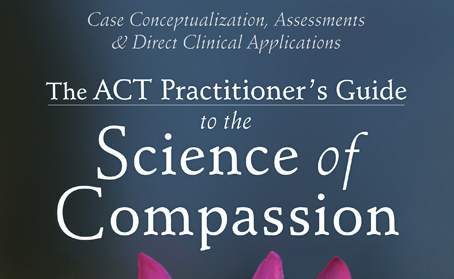A Letter from Tirch, Schoendorff & Silberstein
Compassion is increasingly being studied and used as an evidence-based ingredient in effective psychotherapy. When you consider that practicing compassion has been central to emotional healing in various wisdom traditions for over 2,000 years, this may not seem so surprising. A growing body of research suggests that cultivating our compassionate minds can help alleviate a range of psychological problems. Therapists specializing in acceptance and commitment therapy (ACT) are finding that training in compassion—both toward oneself and toward others—can lead to greater emotional and physical well-being, increased distress tolerance, and a broader range of effective responses to stressful situations. Furthermore, compassion-focused methods are easy to integrate into an ACT approach.
In The ACT Practitioner’s Guide to the Science of Compassion, we have provided ACT practitioners and other therapists a step-by-step guide to the growing science of compassion, drawing from ACT, functional analytic psychotherapy (FAP), and compassion-focused therapy (CFT). CFT, in turn, draws upon developmental psychology, affective neuroscience, Buddhist philosophy, and evolutionary theory to provide a comprehensive approach to behavior therapy. CFT considers compassion as an emergent process that evolved from human caregiver behaviors. As such, compassion includes a number of the emotional, cognitive, and motivational elements involved in the ability to create opportunities for growth and change. CFT involves training and enhancing our evolved capacity for compassion.
Our book is the first book published to provide an in-depth discussion of compassion in the context of ACT and contextual science. The integrative treatment model it presents provides powerful transdiagnostic tools and outlines processes that can build bridges across therapies. An important addition to any ACT professional’s library, this book explores the emotionally healing benefits of compassion-focused practices when applied to traditional ACT. Blending theory and a hands-on, practical approach, this book offers case conceptualizations, assessments, and direct clinical applications that integrate ACT, FAP, and CFT to enhance your clinical practice.
If you are looking to build on your previous experience with cognitive and behavioral therapies, this book will help you enhance your treatment sessions with clients and increase their psychological flexibility.
Compassion-Focused Tips:
1. Know that it is not your fault.
From a perspective of compassion, we remind ourselves how much of the pain and suffering in life is not of our choosing, and couldn’t really be our fault. We know we didn’t choose our place in the genetic lottery. We didn’t choose to have this tricky human brain, with its hair-trigger threat-detection system and confusing loops of thoughts and actions. We didn’t choose our parents, our childhoods, or the myriad social circumstances of our lives. By realizing that much of what we suffer with and from is simply not our fault, we can begin to activate compassion for ourselves and for others as we move forward into purposeful and engaged living.
2. Practice compassion as a flow between yourself and others.
Practicing consistent compassion for ourselves and others can protect us from the empathic distress fatigue we may experience in therapeutic work, and help build our inner compassionate strength. When you feel as though your reservoir of empathy, wisdom, and warmth has become slightly drained, deliberately breathe in compassionate intentions for yourself. As you exhale, direct compassionate intentions towards your client. You can do this silently, secretly—and consistently. As we breathe in, we wish for our suffering to be alleviated and for ourselves to find peace and happiness. As we breathe out, we wish for the alleviation of our client’s suffering—for their happiness and wellness, and an end to needless struggles. With practice, therapists can quickly activate affiliative emotions to help them work toward their own compassionate mission of alleviating and preventing the suffering that they find in themselves and in others.



 2024 Peace Playbook: 3 Tactics to Avoid Clashes with Your Partner
2024 Peace Playbook: 3 Tactics to Avoid Clashes with Your Partner